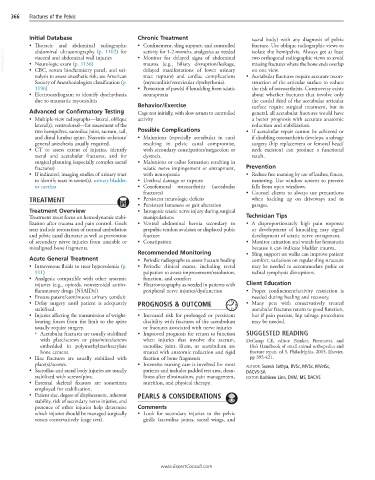Page 774 - Cote clinical veterinary advisor dogs and cats 4th
P. 774
366 Fractures of the Pelvis
Initial Database Chronic Treatment sacral body) with any diagnosis of pelvic
• Thoracic and abdominal radiographs; • Confinement, sling support, and controlled fracture. Use oblique radiographic views to
VetBooks.ir • Neurologic exam (p. 1136) • Monitor for delayed signs of abdominal two orthogonal radiographic views to avoid
isolate the hemipelvis. Always get at least
abdominal ultrasonography (p. 1102) for
activity for 1-2 months, analgesics as needed
visceral and abdominal wall injuries
trauma (e.g., biliary disruption/leakage,
missing fractures where the bone ends overlap
• CBC, serum biochemistry panel, and uri-
on one view.
nalysis to assess anesthetic risk; see American delayed manifestations of lower urinary • Acetabular fractures require accurate recon-
tract rupture) and cardiac complications
Society of Anesthesiologists classification (p. (myocarditis/ventricular dysrhythmia). struction of the articular surface to reduce
1196) • Protection of paw(s) if knuckling from sciatic the risk of osteoarthritis. Controversy exists
• Electrocardiogram to identify dysrhythmia neurapraxia about whether fractures that involve only
due to traumatic myocarditis the caudal third of the acetabular articular
Behavior/Exercise surface require surgical treatment, but in
Advanced or Confirmatory Testing Cage rest initially, with slow return to controlled general, all acetabular fractures would have
• Multiple-view radiographs—lateral, oblique activity a better prognosis with accurate anatomic
lateral(s), ventrodorsal—for assessment of the reduction and stabilization.
two hemipelves, sacroiliac joint, sacrum, tail, Possible Complications • If acetabular repair cannot be achieved or
and distal lumbar spine. Narcotic sedation/ • Malunions (especially acetabular in cats) if disabling osteoarthritis develops, a salvage
general anesthesia usually required. resulting in pelvic canal compromise, surgery (hip replacement or femoral head/
• CT to assess extent of injuries, identify with secondary constipation/megacolon or neck excision) can produce a functional
sacral and acetabular fractures, and for dystocia result.
surgical planning (especially complex sacral • Malunions or callus formation resulting in
fractures) sciatic nerve impingement or entrapment, Prevention
• If indicated, imaging studies of urinary tract with neuropraxia • Reduce free roaming by use of leashes, fences,
to identify tears in ureter(s), urinary bladder, • Urethral damage or rupture neutering. Use window screens to prevent
or urethra • Coxofemoral osteoarthritis (acetabular falls from open windows.
fractures) • Counsel clients to always use precautions
TREATMENT • Persistent neurologic deficits when backing up on driveways and in
• Persistent lameness or gait alteration garages.
Treatment Overview • Iatrogenic sciatic nerve injury during surgical
Treatment must focus on hemodynamic stabi- manipulations Technician Tips
lization after trauma and pain control. Goals • Ventral abdominal hernia secondary to • A disproportionately high pain response
next include restoration of normal ambulation prepubic tendon avulsion or displaced pubic or development of knuckling may signal
and pelvic canal diameter as well as prevention fracture development of sciatic nerve entrapment.
of secondary nerve injuries from unstable or • Constipation • Monitor urination and watch for hematuria
misaligned bone fragments. because it can indicate bladder trauma.
Recommended Monitoring • Sling support on walks can improve patient
Acute General Treatment • Periodic radiographs to assess fracture healing comfort; variations on regular sling structure
• Intravenous fluids to treat hypovolemia (p. • Periodic clinical exams, including rectal may be needed to accommodate pubic or
911) palpation to assess improvement/resolution, ischial symphysis disruptions.
• Analgesia compatible with other systemic function, and comfort
injuries (e.g., opioids, nonsteroidal antiin- • Electromyography as needed in patients with Client Education
flammatory drugs [NSAIDs]) peripheral nerve injuries/dysfunction • Proper confinement/activity restriction is
• Ensure patent/continuous urinary conduit needed during healing and recovery.
• Delay surgery until patient is adequately PROGNOSIS & OUTCOME • Many pets with conservatively treated
stabilized. acetabular fractures return to good function,
• Injuries affecting the transmission of weight- • Increased risk for prolonged or persistent but if pain persists, hip salvage procedures
bearing forces from the limb to the spine disability with fractures of the acetabulum may be needed.
usually require surgery. or fractures associated with nerve injuries
○ Acetabular fractures are usually stabilized • Improved prognosis for return to function SUGGESTED READING
with plate/screws or pins/wires/screws when injuries that involve the sacrum, DeCamp CE, editor: Brinker, Piermattei, and
embedded in polymethylmethacrylate sacroiliac joint, ilium, or acetabulum are Flo’s Handbook of small animal orthopedics and
bone cement. treated with anatomic reduction and rigid fracture repair, ed 5, Philadelphia, 2015, Elsevier,
• Iliac fractures are usually stabilized with fixation of bone fragments pp 395-421.
plate(s)/screws. • Intensive nursing care is involved for most AUTHOR: Suresh Sathya, BVSc, MVSc, MVetSc,
• Sacroiliac and sacral body injuries are usually patients and includes padded rest area, clean- DACVS-SA
stabilized with screws/pins. liness after eliminations, pain management, EDITOR: Kathleen Linn, DVM, MS, DACVS
• External skeletal fixators are sometimes nutrition, and physical therapy.
employed for stabilization.
• Patient size, degree of displacement, inherent PEARLS & CONSIDERATIONS
stability, risk of secondary nerve injuries, and
presence of other injuries help determine Comments
which injuries should be managed surgically • Look for secondary injuries to the pelvic
versus conservatively (cage rest). girdle (sacroiliac joints, sacral wings, and
www.ExpertConsult.com

